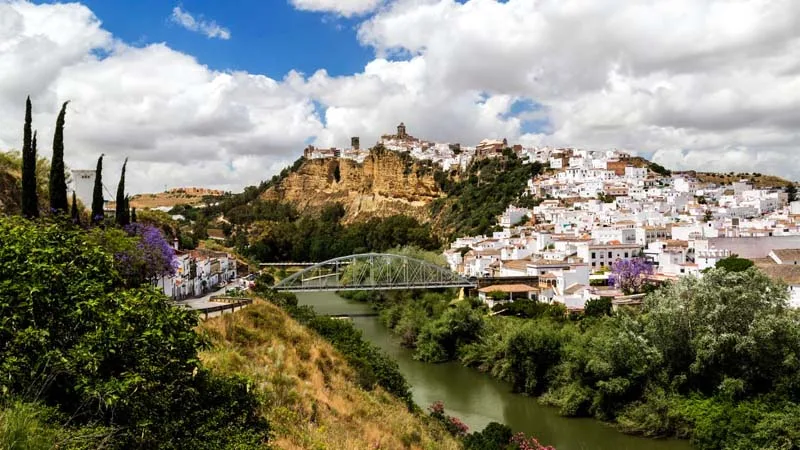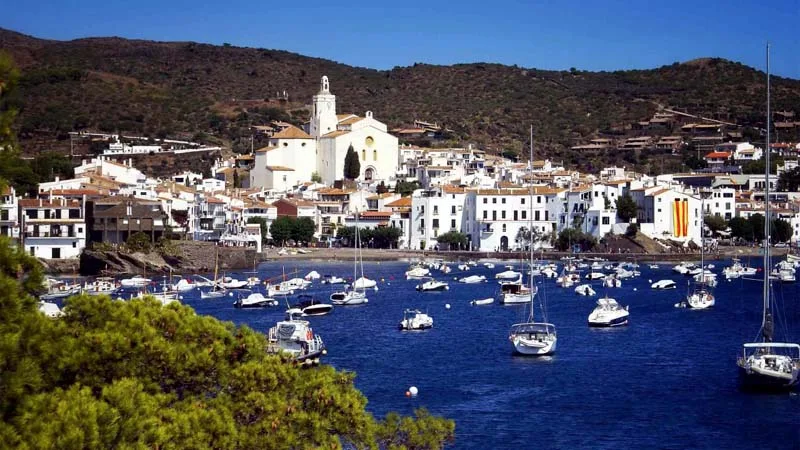For unspoiled nature, centuries-old architecture, and guaranteed tranquility, hole up in one of these postcard-perfect villages.

If you’ve been to Spain, chances are you’ve spent a few days in Madrid or Barcelona. Maybe you’ve shouted ¡Olé! at a flamenco show in Seville, feasted on paella in Valencia, or embarked on a pintxo crawl in San Sebastian. But there’s far more to Spain than its bustling metropolises: These nine villages—whether tucked between mountains, teetering on cliff sides, or perched at the ocean’s edge—offer unhurried, intimate visions of the Iberian Peninsula that their urban counterparts simply can’t.
Getaria
 |
| A view of Getaria beyond the Txakoli vineyards |
[post_ads_2]
Where to Stay: Time stands still at Hotel Iturregi, a luxury lodge situated among txakoli vineyards that sprawl out toward the Bay of Biscay. When you’re not at the beach in Getaria (an eight-minute drive away), take advantage of the expansive sun-drenched terraces and a serene outdoor pool.
El Golfo
 |
| The green lagoon in El Golfo, Lanzarote island, Spain |
[post_ads]Most travelers to Lanzarote, the easternmost Canary Island, flock to
the cookie-cutter resorts of Playa Blanca—and they’re missing out. To
truly experience Canarian culture, avoid the tourist bubble and instead
hole up in El Golfo, a picturesque fishing village with a population of
under 200. Beyond the town’s exceptional seafood restaurants (Mar Azul
edges out the competition) and amiable inhabitants (expect the
occasional ¡hola! from complete strangers), its main draw is
its moonlike volcanic landscapes. There’s a neon-green lake, black-sand
beaches, and wispy red dunes, and in the distance, the dormant volcanoes
of Timanfaya National Park loom on the horizon.
Where to Stay: Fall asleep to the lull of the surf at El Hotelito del Golfo, a pleasant little hotel with a pool and outdoor showers. Be sure to request a room with ocean views.
If you’ve ever fantasized about stepping into a Spanish Golden Age
novel, consider spending a day or two in Consuegra, a town 85 miles
south of Madrid in Castilla–La Mancha hemmed in by 16th-century
windmills—or “hulking giants,” as Don Quixote called them. One of the
windmills is open to the public and acts as a small museum. When you’ve
finished strolling (or jousting) along the ridge, tour the Castillo de
La Muela, the region’s best-preserved castle. Of course, you can’t leave
La Mancha without stocking up on manchego cheese and the world’s best
saffron (sold at La Bodeguita Gourmet).
[post_ads_2]
Where to Stay: La Vida de Antes loosely translates to “the good old days,” and true to its name, there’s no shortage of nostalgia at this tiny hotel. Tile-floored rooms, outfitted with vintage furniture and paintings of local landscapes, are organized around a traditional Manchegan courtyard.
Consuegra
 |
| The famed windmills of La Mancha |
[post_ads_2]
Where to Stay: La Vida de Antes loosely translates to “the good old days,” and true to its name, there’s no shortage of nostalgia at this tiny hotel. Tile-floored rooms, outfitted with vintage furniture and paintings of local landscapes, are organized around a traditional Manchegan courtyard.
Tudela
 |
| Picture of Tudela from hill above the town, El Cerro de Santa Barbara. Tudela, Navarre, Spain |
Arcos de la Frontera
 |
| Village on hillside near bridge and river, Arcos de la Frontera, Andalusia, Spain |
Where to Stay: El Parador de Arcos de la Frontera, which occupies the mansion of a formal local magistrate, towers over the main square and the Guadalete River below.
Cudillero
 |
| The colorful houses of Cudillero's port |
[post_ads_2]
Where to Stay: Situated in what was once a fish-curing factory, La Casona de Pío is a family-run inn with simple, snug rooms and thoughtfully prepared breakfasts (think homemade crêpes, from-scratch cakes, and freshly made tortilla española).
Cadaqués
 |
| White village of Cadaqués in Costa Brava, Catalonia, Spain |
[post_ads]When Catalans talk about Cadaqués, they use superlatives: “It’s the most beautiful village of the Costa Brava”; “It boasts the most scenic viewpoint in all of Spain”; “It’s where the best
Spanish minds found inspiration”—and so on. Indeed, the whitewashed
town once lured such luminaries as Federico García Lorca, Salvador Dalí,
Marcel Duchamp, Luis Buñuel, and Pablo Picasso. Dalí, who drew on the
area’s scrubby Mediterranean landscape in paintings like The Persistence of Memory and Port of Cadaqués, lived in neighboring Portlligat with his wife, Gala, for 40 years. Today the residence is a museum
where you can marvel at such oddities as a taxidermied polar bear
strewn with jewels and a mirror system Dalí devised to see the sunrise
from his bed.
Where to Stay: Awash with mellow earth tones and dappled with sunlight, rooms at Tramuntana Hotel
evoke a spa-like calm. And you couldn’t ask for a better location: The
Old Town is right outside, and the beach is a two-minute walk away.
Sóller

[post_ads]To get to Sóller, Mallorca, you can hop aboard a wooden tram (built
in 1912) in La Palma that judders and clacks through pastel-pink almond
groves and rolling green pastures. The fairy-tale journey is a fitting
prelude to Sóller’s splendid charms including Sant Bartomeu, a
16th-century church redeveloped by a Gaudí disciple; Can Prunera,
a Modernisme museum housing works by the likes of Fernand Léger and
Paul Klee; and Sala Picasso & Sala Miró, a permanent exhibition of
ceramics and prints by the eponymous artists displayed on the ground
floor of the train station.
Where to Stay: Pamper yourself at Jumeirah Port Sóller Hotel & Spa,
a five-star property with ocean views, an infinity pool, and a
cliff-top spa in Puerto de Sóller (two miles from Sóller proper).
Alquézar
 |
| The Medieval Village of Alquezar is situated on the River Vero and is a World Heritage Site by UNESCO |
[post_ads]A sea of terracotta roofs that culminates in a 11th-century Moorish
fortress, Alquézar—set in the foothills of the Pyrenees—appeals not only
for its medieval atmosphere but also for its distinctive geology. Go
canyoning with Buenaventura,
a local tour company, and spend a morning sliding down chutes,
squeezing under rocks, and cannonballing into cobalt-blue pools. After
all that physical exertion, reward yourself with a leisurely wine
tasting at Viñas del Vero,
a bodega located 20 minutes outside town that epitomizes the
experimental verve of the Somontano wine region: After a Segway tour
through the vineyards, savor a glass of gewürztraminer, a lychee-scented
German grape that’s a rarity in Spain.
Where to Stay: With beamed ceilings, unpolished stone floors, and cheerily patterned linens, rooms at Alodia hit the sweet spot between rusticity and coziness. Ask for a room with unencumbered views of the old town.
See more at: The Daily Beast
























